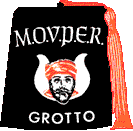
The fez was named for the city of Fez, in Morocco. Formerly, the city of Fez had a monopoly on the manufacture of that peculiar form of headdress because it controlled the juice of the berry used to color the fezzes. Since the discovery of synthetic dyes, they have been manufactured in various countries including France, Germany and Austria. At the turn of the last century Austria had become the chief center of the fez industry and countries where the fezzes were extensively used did not have a single fez manufacturing plant.
The shape of the cap is a truncated cone familiar to all the Prophets. It was made of black felt, having a red tassel inserted in the middle of the top and hanging down. The shape and the tassel of the fez worn by Grotto Prophets are of the same type as worn throughout Turkey. Fezzes in Tunisia, Tripoli and Morocco, are generally twice or three times as long and have blue silk tassels much longer and heavier than those found in America and Turkey.
In the early part of the nineteenth century the fez was made a part of the Turkish official dress by Mahmoul II, Sultan of Turkey. It was considered the special badge of a Turkish subject and he, even if not a Moslem, was obliged to wear it. Women as well as men wore fezzes but theirs were usually smaller and without tassels.
Soon after the inauguration of the new Turkish regime by the young Turks, a national misunderstanding arose between the Turkish and Austrian peoples, and the former vowed they would boycott all Austrian goods including the fez. Destroying the fezzes that they had and refusing to buy new ones, the people throughout turkey, for some months, covered their heads with Persian caps or with any headgear that they could improvise.
The fez was worn either with or without a turban by Moslems, Christians and Jews. The Turkish soldiers and other public officials except certain ecclesiastical dignitaries in Turkey, including the Sultan, wore their fezzes without the turban.
Among the Moslems, those who can trace their genealogy back to Mohammed wore green turbans, all others wore white or some other color dictated by local custom, personal taste or fancy.
About 980 A.D., when the pilgrimages to Mecca were interrupted by the Crusades, Mohammedans and those of the Moslem faith living west of the Nile, journeyed to Fez as to the Holy City. A manufacturer in Fez began supplying to the students, of the university, a scarlet tarbush, which was the insignia of the school. This was the means by which students were readily recognized. The fez, as the tarbush was called, was carried by pilgrims who wore similar pieces of headgear. The fez soon came to be worn all along the northern shores of Africa, and its use gradually extended east of the Nile.
For the first few years of existence, the Mystic Order of Veiled Prophets of the Enchanted Realm had no official emblem to wear. Prophets desired to have an emblem that set them apart from others and a black Fez head covering was selected with a Mokena Head in the center, giving the name of the Grotto.
The minutes of a February 26, 1903 Stated Meeting of Azim Grotto, Bronx, New York states: “Prophet Charles E. Lansing, Past Potent Monarch, after some preliminary remarks, descriptive thereto, presented to those present, a drawing in color of a headgear appropriate for the Order. The same was received with favor and by motion, regularly made and seconded and carried, it was unanimously decided to adopt and wear them on serious and other appropriate occasions.”
In the minutes of October 29, 1903, it is recorded: “The Potent Monarch reported that the Fez worn by our members was, at the Annual Session of the Supreme Council held at Hamilton, New York on October 20, be adopted as the official headgear for all Prophets of the Realm,”
